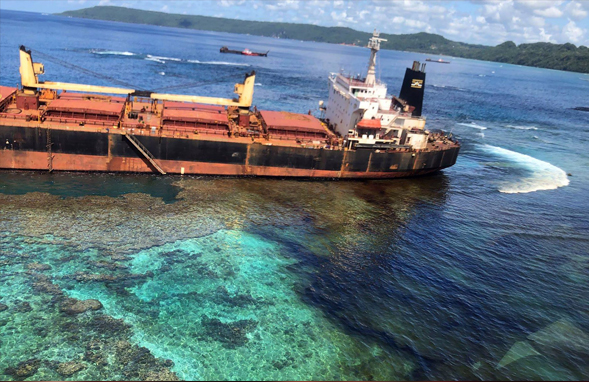

Hong Kong-flagged ship ran aground near the UNESCO protected world heritage site of East Rennell in the Solomon Islands, a month ago. The subsequent leak led to an oil spill, which has now become a primary threat to the ecosystem and population of Rennell Island
A month ago, Hong Kong-flagged cargo ship—Solomon Trader—carrying over seven hundred tons of fuel oil, ran aground on one of the Solomon Islands. It is now leaking very close to the borders of the UNESCO protected world heritage site, East Rennell. The site is situated on the Rennell Island and according to the United Nations, it is the world’s largest raised coral atoll. Reportedly, the subsequent oil spill is now posing a serious threat to the ecosystem and the population of Rennell Island.
The oil spill, which has now become the primary concern of environmentalists, has already spread across over 4 km of the coastline. Solomon Islands’ close ally, Australia, sent experts to the site for examining the conditions on Sunday. According to Australian officials, the oil spill has spread into the surrounding sea and is now bordering East Rennell. To limit the damage in Rennell Island, Australian Foreign Minister, Marise Payne, has assured further assistance. The country would be sending experts and equipment to curb the situation in the Solomon Islands.
Reportedly, the Solomon Islands’ government had called on the Australian Department of Foreign Affairs and Trade for gaining control over the situation amid the slow response of the cargo ship’s owner, King Trader. On Tuesday, the Australian department affirmed that over six hundred tons of oil still remained in the vessel and there was a “high risk” of it leaking into the sea, damaging the ecosystem further.
The Korea Protection and Indemnity Club is the insurer for the vessel’s owner and have issued a statement expressing “deep remorse” with regards to the oil spill. However, the firm did assert that the liability for the matter is “yet to be determined.” The indemnity club claimed that soon after the ship was run aground, they made efforts to retract the vessel using a tugboat. However, a sudden cyclone and harsh weather conditions “made it difficult and at times impossible to access the vessel, and conditions have been too dangerous for external underwater inspections — a key assessment ahead of salvage operations progressing in earnest.”
The impact of the oil spill on the Island’s population, which largely depends on the natural resources of the ocean and the island, has also become a matter of grave concern. Surrounding coastal villages of Matanga, Vangu, Lavangu and Kangava are already facing the adversities of the disaster. The villagers, who were highly dependent on fishing for sustaining their livelihoods, have to now wait for food packages that arrive from the capital city of Honiara, over 240 km away, for survival.
While a villager from Lavangu village said, “Now we cannot use our sea and reef to do fishing and find shells to eat. We really suffered from it”, another living near Kangava Bay explained, “The oil slick affects our corals and marine life. It also contaminates our water which comes out from the stones on the land near the beach. So now we run out of clean water to drink.”
UNESCO has previously described the oil spill site as a “true natural laboratory for scientific study.” The organisation listed East Rennell under world’s endangered heritage sites in 2013, amid increasing threats of exploitative commercialisation.
Elaborating the need for instant action, Greenpeace Australia Pacific has now asserted, “This requires immediate action, compensation and remediation.”








